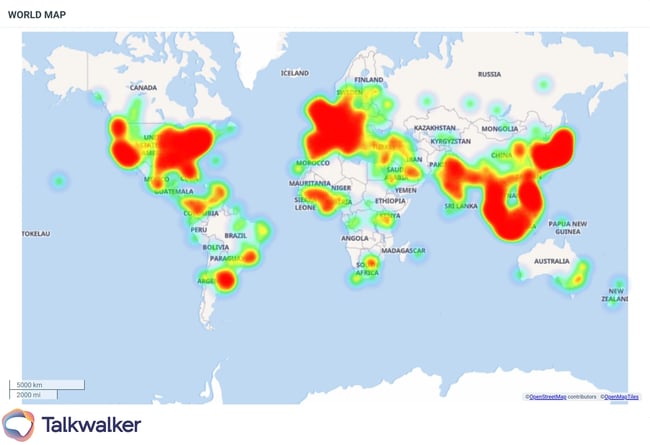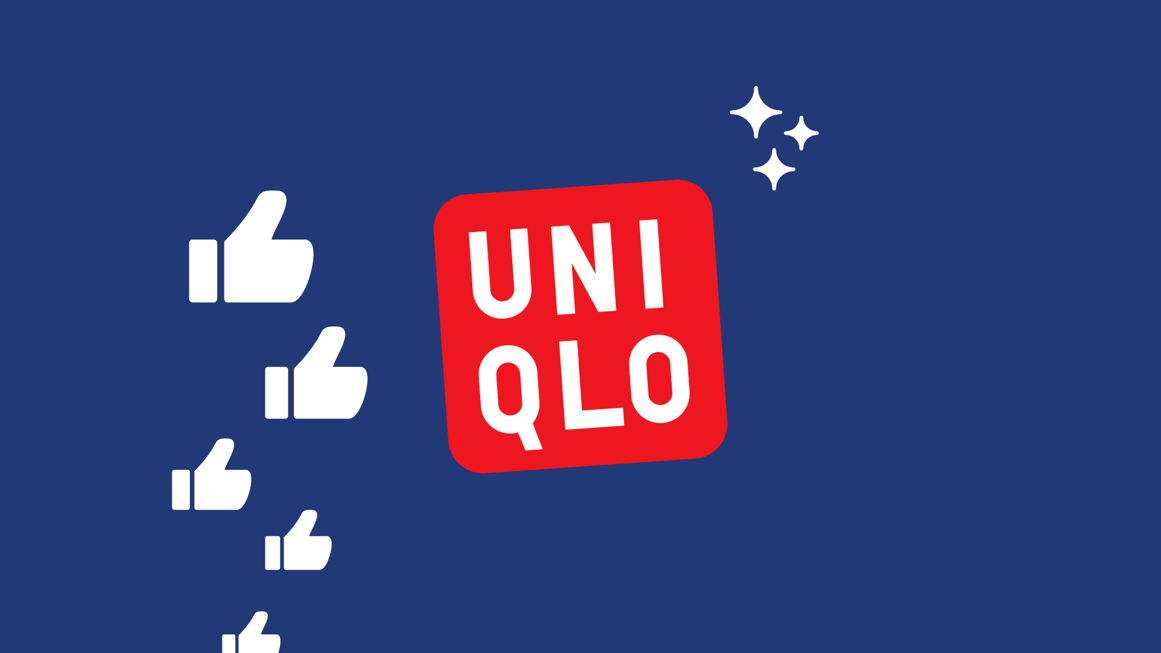Contents
- UNIQLO’s marketing strategy
- 1. Using the product as a platform for marketing and raising brand awareness
- 2. Investing in experiential marketing and delivering customer experience (CX) excellence
- 3. Marketing sustainability in a fast-fashion world
- 4. Seeing e-commerce as a marketing channel to boost in-store sales
- 5. Designing engaging omnichannel experiences
- 6. Collaborating with top influencers to take the UNIQLO brand to the next level
- 7. Publishing localized social media content
- FAQs
- Conclusion
UNIQLO has transformed from a men's clothing shop in Japan to a global fashion powerhouse.
Its parent company, Fast Retailing, began operating in 1949.
In 1984, the company opened its first store in Hiroshima called "Unique Clothing Warehouse."
The name "UNIQLO" was born by chance when an employee misread the "C" as "Q" while registering the company in Hong Kong.
And then it began.
UNIQLO opened its first overseas store in London and began its global expansion in 2001.
Today, Fast Retailing is the biggest clothing retailer in Asia. And UNIQLO’s e-commerce and retail revenue reached a record-breaking $6.23 billion in 2025.
Wondering how they did it? Let’s figure it out together.
This case study explores UNIQLO’s marketing strategy, analyzing the key success factors and listing takeaways for businesses like yours.
 UNIQLO brand mentions all around the world, found using Talkwalker Social Listening.
UNIQLO brand mentions all around the world, found using Talkwalker Social Listening.
UNIQLO’s marketing strategy
The fashion industry never stops. New trends pop up daily, and thousands of brands are fighting for attention.
But UNIQLO is doing something different.
“We don’t chase trends. People mistakenly say that UNIQLO is a fast-fashion brand. We’re not. We are about clothing that’s made for everyone.”
CEO Tadashi Yanai UNIQLO | Source: Business Insider
While other brands try to copy the latest trends, UNIQLO prioritizes product development.
They invest in new technology and advanced materials—even when it takes time to get it right.
The goal? To show that UNIQLO’s brand serves a clear purpose: creating innovative clothing accessible to anyone.
As a result, they’ve built a brand that people love and trust.

UNIQLO brand mentions over 6 months, found using Talkwalker Social Listening.
Get insights on becoming a loved brand like UNIQLO!
Let's break down why and how this works so well.
1. Using the product as a platform for marketing and raising brand awareness
In 2003, UNIQLO introduced its flagship heat-generating clothing line known as HEATTECH.
It was probably UNIQLO's smartest marketing move.
The concept is simple: the fabric absorbs your body's moisture to generate heat, letting you stay warm without bulky layers.

Source: UNIQLO
But here's what made it brilliant for marketing: UNIQLO turned the development story into its brand story.
They partnered with Japanese chemical company Toray Industries and tested over 10,000 prototypes.
This showed they were serious about innovation and quality and gave UNIQLO’s brand a voice.
Every time they improved HEATTECH over the years, it was another chance to grab attention.

Source: UNIQLO
“Transforming winter from a cold, heavy clothes season to a warm, lightweight dress season" became more than just a promise of improved product functionality.
It was a way to show that UNIQLO thinks differently about fashion.
And the company didn’t stop there. It keeps introducing innovative product lines and concepts—like its PUFFTECH clothing.

2. Investing in experiential marketing and delivering customer experience (CX) excellence
UNIQLO improves customer experience in two ways: innovative marketing campaigns that get people talking and special attention to in-store service.
For example, they launched the "fast-moving images" campaign for HEATTECH.
They put up digital billboards in busy Australian spots and ran online ads with images flashing so fast you couldn't read them—unless you took a photo.
Each photo revealed a code that unlocked product videos, discounts, and gifts.

Source: Shorty Awards
People had to interact with the brand to get the reward, and many shared the experience on social media.
The campaign reached 4M people and brought in 35,000 new customers, earning UNIQLO a Shorty Award for Best in Retail and E-Commerce in Social Media.
The brand also works hard to create excellent in-store customer experiences.
Ever noticed how every UNIQLO store feels the same, whether you're in Barcelona or New York?
It’s all part of intense staff training. Everything is choreographed, from how employees interact with customers to the way they hand back credit cards.
This obsession with detail has paid off.
In Singapore, for example, UNIQLO was ranked the #1 place to work in 2020. As they put it: "Our greatest asset is our people." And it shows in every customer interaction.
The brand also uses the latest technology to boost in-store experiences. For example, you can find self-checkout machines in many of its shops worldwide.

Source: WSJ
3. Marketing sustainability in a fast-fashion world
UNIQLO opposed the fast fashion trend by introducing its LifeWear concept.
Instead of pushing trendy clothes that fall apart after three washes, they offer reasonably priced, high-quality clothing designed to last.
Through this philosophy, UNIQLO has attracted customers who advocate for responsible materials and manufacturing processes.

Source: UNIQLO
UNIQLO’s commitment also shows in the RE.UNIQLO Studio program where customers can get their clothes repaired, remade, or recycled.
Need a patch on your favorite UNIQLO jeans? Bring them in.
And of course, the brand carries out other sustainable initiatives.
For example, they replaced plastic shopping bags with ECO Bags. This translates UNIQLO’s brand value proposition: durability and sustainability.

4. Seeing e-commerce as a marketing channel to boost in-store sales
Many brands see e-commerce and physical stores as competing channels. But UNIQLO gets how blurred these lines can be for modern shoppers.
"We have noticed that the more our e-commerce services expand, the more often customers tend to purchase items from our physical stores. For example, rather than go to stores to search, our Chinese customers tend to select products they think sound most attractive based on information they found online. When we launch a new UNIQLO product, customers actively share information about the product on social media, spurring sales both online and in our stores."
- Tadashi Yanai, Founder of UNIQLO
For example, here’s a post by a happy UNIQLO customer:

Shopping habits keep changing. And while online channels are essential, brands need to connect the dots.
UNIQLO figured it out: they make online and physical stores work together, not against each other.
Let’s look at this in detail.
5. Designing engaging omnichannel experiences
UNIQLO puts a lot of effort into connecting online and in-store experiences.
Their strategy? Being everywhere their customers are—from airports to mobile phones to flagship stores.
For example, shoppers in select UNIQLO stores worldwide can create custom t-shirts and tote bags using the UTme! service.
All you need to do is create your design on an in-store tablet, and it will be ready within 10 minutes.

Source: Auburn Lane
UNIQLO also connects offline and online experiences via its website and mobile app.
For example, you can check stock levels, buy online, and pick it up in-store (or get it delivered).

The result? A shopping experience that works the same whether you're on your phone at midnight or walking into a store at noon.
6. Collaborating with top influencers to take the UNIQLO brand to the next level
UNIQLO's marketing strategy relies heavily on smart collaborations.
They pick partners that align with their brand values and help them reach new audiences.
For example, they choose their athlete ambassadors for what they represent.
Take their current lineup:
- Ayumu Hirano, the Olympic snowboarder known for pushing boundaries
- Gordon Reid, the wheelchair tennis champion who became the UK's youngest national champion at 15
- Roger Federer, a professional tennis player who held ATP Tour No.1 for a record 237 consecutive weeks and dominated Wimbledon with eight titles

But UNIQLO doesn't stop at sports.
Their design collaborations—from MARNI to JW Anderson and Marimekko—help them tap into different style communities.

Each partnership creates buzz on social media and draws new customers to Uniqlo’s stores.
7. Publishing localized social media content
Finally, UNIQLO runs separate social media accounts for different markets—with localized content plans for each region.
From @uniqlo_jp to @uniqloindonesia, each account speaks to its local audience.

This approach does four key things for UNIQLO’s brand:
- It lets them share their brand story in ways that resonate with each market
- It turns customers into content creators: when UNIQLO launches products, locals share and discuss in their own authentic way
- It powers their digital marketing: these local accounts drive engagement better than one-size-fits-all content would
- In balances their marketing strategy: from working with local influencers to publishing UCG content

FAQs
What marketing strategy does UNIQLO use?
As a global clothing brand, UNIQLO leverages product development, experiential marketing, and a strong brand identity.
Their pricing strategy balances competitive pricing with product innovation and quality.
They also use an omnichannel approach to marketing, connecting offline experiences with online channels like social media platforms.
Who is UNIQLO's target market?
UNIQLO targets a broad demographic—from young professionals to families.
Their key focus is producing quality clothing that fits everyone and is inclusive.
UNIQLO’s success largely comes from understanding its diverse customer base and its values.
What makes UNIQLO so unique?
UNIQLO has built a strong brand around lasting quality and innovation, which sets it apart from fast-fashion brands like Zara.
Their brand story focuses on providing “LifeWear”—clothing that improves daily life through simplicity and comfort.
In other words, UNIQLO’s product development aligns with its brand story and marketing messages. Which creates trust and recognition among its customers.
How does UNIQLO use digital marketing strategies?
UNIQLO uses social media, influencer collaborations, paid campaigns, email, and other channels to engage customers online.
They also focus on integrating offline and online experiences.
For example, by connecting e-commerce platforms with physical stores through the order-and-pickup option.
What is the role of innovation in UNIQLO's marketing strategy?
UNIQLO integrates innovation into three key areas:
- Product development: e.g., its HEATTECH and AIRism product lines
- Retail experience: e.g., AR mirrors in stores and custom t-shirt stations
- Marketing campaigns: e.g., the “fast-moving images” campaign
Overall, UNIQLO positions itself as a technology-driven brand—much like Apple in consumer electronics.
How does UNIQLO's marketing strategy emphasize its brand values?
UNIQLO’s marketing strategy goes in line with its brand story. For example:
- Their marketing stays away from the usual fashion hype. No supermodels or fancy photoshoots—just clear information about how their clothes work.
- While other brands push weekly trends, UNIQLO talks about materials and durability.
- Every marketing campaign ties back to UNIQLO’s development process and the technology behind it.
- Their marketing also shows real people using their clothes in everyday situations.

Conclusion
UNIQLO's marketing success comes from understanding several key principles:
- Products do their own marketing when they solve real problems. Rather than chasing trends, UNIQLO invests in innovations that address their customers’ needs.
- Digital and physical retail work better together than apart. Instead of treating them as competing channels, UNIQLO connects online shopping with in-store experiences.
- Local markets need local voices. UNIQLO adapts its global message to local markets through localized social media content.
Last but not least: UNIQLO always stays true to its core brand promise.
Would you like to repeat their success?
Always start with listening to your audience to understand what they want. Try Talkwalker's Social Listening tool to make it possible.



